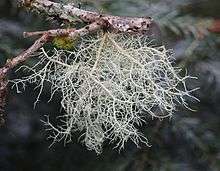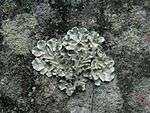Lichen growth forms



Lichens are grouped by common lichen growth forms. There are a wide range of growth forms (morphology). These groupings may not be consistent with lichen taxonomy, since lichens with similar growth forms are not necessarily related by ancestry. Groups based on growth may overlap and have borderline cases. A species usually has the same overall growth form wherever it is found, but not always.[1]
Common groupings of lichens based on overall growth form include 1. bushy or shrubby (fruticose) 2. leafy (foliose) 3. crust-like (crustose) 4. scaly (squamulose) 5. stringy (filamentose), 6. whispy (Byssoid), 7. powdery (leprose), or 8. structureless (e.g., gelatinous). Ways of grouping by growth forms is usually based on the form of the part of lichen that is not involved in sexual reproduction, the "vegetative" part, which is called the thallus. This includes both the fungus (mycobiont) and the algae and/or cyanobacteria cells (photobiont) they surround, but does not include any part with sexual fruit bodies of the mycobiont. The thallus may or may not have a "skin", a surface layer of differentiated tissue that covers the undifferentiated middle tissue, the medulla. When part of a lichen has a cortex it is called corticate.[2] If it lacks a cortex it is called ecorticate.[3]
A simple way to group lichens that requires use of a microscope to see a lichen's surface structure (anatomy) is by the presence or absence of a "skin" (cortex). Fruticose lichens have one cortex encircling the "branches", even when the branches are flattened and look like "leaves". Foliose lichens have a separate upper cortex and lower cortex on each side of the "leaf". Crustose and squamulose lichens have an upper cortex, but do not have a lower cortex. Filimentous, byssoid, leprose, and other lichens do not have a cortex (are ecorticate).
The following are commonly used groupings for lichens:
- 1. fruticose (branched, 3-dimiensional, one cortex surrounds thallus), e.g., Cladonia evansii, C. subtenuis, and Usnea australis - The thallus is extended up, or hangs down, in a branched or tufted structure.
- 2. foliose (leafy, 2-dimensional planes, two cortices – upper and lower), e.g., Hypogymnia physodes – The thallus generally forms flat, leaf-like lobes that are not firmly bonded to the substrate, with the underside having its own cortex.
- 3. Crustose lichens (paint-like, flat, 2-dimensional, upper cortex, no lower cortex), e.g., Caloplaca marina - The thallus lies flat and tightly bound at all points to the substrate, like it is painted on.
- 3a. Crustose placodioid (flattened and radiating out from a center, possibly raising up to being leaf-like at the outer edges with no cortex under raised part if present) - The thallus structure radiates out, with the outer edges peeling up from the substrate at the tips. These may peel up so much as to appear like foliose lichens, but unlike foliose lichens, they lack a cortex under the edges that lift from the substrate.
- 4. squamulose (scale-like or platelet-like, upper cortex but no lower cortex under raised portion), e.g., Normandina pulchella - The thallus is composed of mostly flat laying, overlapping, scale-like plates ("squamules"), which may become leaf-like in form where they are not attached to the substrate, but which do not have a lower cortex on the underside. Some lichenologists consider squamulous lichens to be a special kind of crustose lichen.[1]
- 5. Filamentous (hairlike), e.g., Ephebe lanata, Cystocoleus ebeneus – The thallus forms mostly nonbranching hair-like structures that may look overall like matted hair.
- 6. Byssoid (whispy), e.g., Coenogonium implexum – Whispy like teased cotton or teased wool.[1]
- 7. leprose (powdery), e.g., Lepraria incana – The thallus is a layer so thin that it is almost like a powder stuck to the substrate.
- 8. Structureless – Lichens may not have a recognizable thallus structure, including gelatinous lichens where the cyanobacteria produce a polysaccharide that absorbs and retains water.
Since growth forms may be variable, there are gray areas between these groups, and there is overlap, placement of lichens in these groups is not definite. Placement of a lichen in one of these groups may vary from author to author.
Sometimes, such as when the thallus grows inside solid rock, between the grains, only the fruiting part of a lichen is visible, and this may be visible in a dramatic way (e.g., Caloplaca luteominea subspecies bolandri).[4]
References
- 1 2 3 What is a lichen?, Australian National Botanical Garden
- ↑ Alan Silverside's Lichen Glossary (a-f), Alan Silverside
- ↑ Alan Silverside's Lichen Glossary (g-o), Alan Silverside
- ↑ Lichen Vocabulary, LICHENS OF NORTH AMERICA, Sylvia and Stephen Sharnoff,